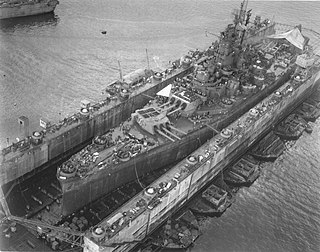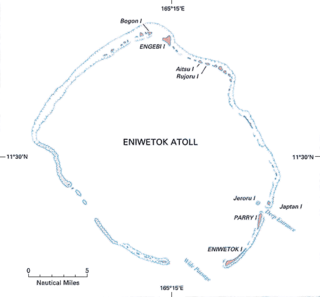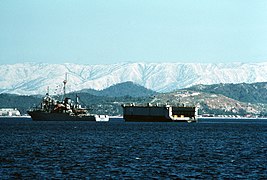
The third USS Ability (AFD-7/AFDL-7) was a small auxiliary floating drydock in the service of the United States Navy.

ABSD-7, an advanced base sectional dock, was constructed of seven advance base docks (ABD) as follows: ABD-37, ABD-38, ABD-39, and ABD-40 were built by Chicago Bridge & Iron Company, Morgan City, Louisiana, and completed in December 1944 and January and February 1945; ABD-51 and ABD-52 were built by Pollock-Stockton Shipbuilding Company, Stockton, California, and completed in January and March 1945; and ABD-58 was built by Pittsburgh-Des Moines Steel Co., Pittsburgh, Pennsylvania, and completed in October 1944.

USS Artisan (ABSD-1), later redesignated as (AFDB-1), was a ten-section, non-self-propelled, large auxiliary floating drydock of the United States Navy. The only U.S. warship with this name, Artisan was constructed in sections during 1942 and 1943 by the Everett-Pacific Shipbuilding & Dry Dock Company, in Everett, Washington; the Chicago Bridge & Iron Company, in Eureka, California; the Pollock-Stockton Shipbuilding Company, in Stockton, California; and the Chicago Bridge & Iron Company, in Morgan City, Louisiana. This ship was commissioned at Everett, Washington, on 10 May 1943, Captain Andrew R. Mack in command. With all ten sections joined, she was 927 feet (283 m) long, 28 feet (8.5 m) tall, and with an inside clear width of 133 feet 7 inches (40.72 m).

An auxiliary repair dock (ARD) is a type of floating drydock employed by the U.S. Navy, especially during World War II. The Navy commissioned 33 ARD vessels: ARD-1 through ARD-33. ARDs were self-sustaining in World War II. ARDs have a rudder to help in tow moving, making ARDs very mobile, and have a bow to cut through waves. ARDs have a stern that can be opened or closed. The stern can be closed with bottom-hinged flap gate, operated by hydraulic rams. This stern gate can be lowered for ship entrance into the submerged dock, and then closed to keep out waves. ARDs were built by the Pacific Bridge Company, in Alameda, California.

USS Richland (YFD-64/AFDM-8) was an AFDM-3-class medium auxiliary floating drydock built in California for the U.S. Navy. Originally named USS YFD-64, she was towed to the Philippines and Guam where she served until war's end.

USS ARD-29 was an auxiliary repair dock that served with the United States Navy during World War II as an Auxiliary floating drydock. In 1967, the ship was renamed Arco, and in the 1970s the vessel was first loaned, and later sold, to Iran.

USS Endeavor was a 200-foot AFDL-1 Class Small Auxiliary floating drydock in service with the United States Navy during World War II. Built and delivered by Chicago Bridge and Iron in Morgan City, Louisiana in September 1943, she entered service as USS AFD-1. She was redesignated AFDL-1 on 1 August 1946. In 1986, she was decommissioned, struck from the Naval Register and transferred to the Dominican Republic and redesignated DF-1. She is currently in Active Service as of 2017.

An auxiliary floating drydock is a type of US Navy auxiliary floating dry dock. Floating dry docks are able to submerge underwater and to be placed under a ship in need of repair below the water line. Water is then pumped out of the floating dry dock, raising the ship out of the water. The ship becomes blocked on the deck of the floating dry dock for repair. Most floating dry docks have no engine and are towed by tugboats to their destinations. Floating dry docks come in different sizes to accommodate varying ship sizes, while large floating dry docks come in sections and can be combined to increase their size and lift power. Ballast pontoon tanks are flooded with water to submerge or pumped dry to raise the ship.

USS AFDM-2,, is an AFDM-3-class medium auxiliary floating drydock built in Mobile, Alabama by the Alabama Drydock and Shipbuilding Company for the U.S. Navy. Originally named USS YFD-4, Yard Floating Dock-4, she operated by Todd Shipyards at New Orleans, Louisiana for the repair of US ships during World War II. YFD-4 was renamed an Auxiliary Floating Dock Medium AFDM-2 in 1945 after the war.

ABSD-3 is an advanced base sectional dock, constructed of nine advance base dock (ABD) sections for the US Navy as an auxiliary floating drydock for World War II. ABSD-3 was delivered to the US Navy in April 1944, and was commissioned on 27 October 1944. Advance Base Sectional Dock-3 was constructed in sections during 1942 and 1943.

ABSD-6 is an advanced base sectional dock which was constructed of nine advance base docks (ABD) sections for the US Navy as an auxiliary floating drydock for World War II. ABSD-6 was built by Mare Island Naval Shipyard at Vallejo, California. ABSD-6 was commissioned on 28 September 1944. Advance Base Sectional Dock-6 was constructed in sections during 1942 and 1943. Each section are 3,850 tons and are 93 feet long each. Each Section had a 165 feet beam, a 75 feet molded depth and had 10,000 tons lifting capacity each. There were 4 ballast compartments in each section. With all nine sections joined, she was 825 feet long, 28 feet tall, and with an inside clear width of 133 feet 7 inches. ABSD-2 had a traveling 15-ton capacity crane with an 85-foot radius and two or more support barges. The two side walls were folded down under tow to reduce wind resistance and lower the center of gravity. ABSD-6 had 6 capstans for pulling, each rated at 24,000 lbf (110,000 N) at 30 ft/min (0.15 m/s), 4 of the capstans were reversible.

USS ABSD-5, later redesignated as AFDB-5, was a nine-section, non-self-propelled, large auxiliary floating drydock of the US Navy. Advance Base Sectional Dock-5 was constructed in sections during 1943 and 1944 by the Chicago Bridge & Iron Company in Morgan City, Louisiana for World War II. With all nine sections joined, she was 825 feet long, 28 feet tall, and with an inside clear width of 133 feet 7 inches. ABSD-5 had two traveling 15-ton capacity crane with an 85-foot radius and two or more support barges. The two side walls were folded down under tow to reduce wind resistance and lower the center of gravity. ABSD-5 had 6 capstans for pulling, each rated at 24,000 lbf (110,000 N) at 30 ft/min (0.15 m/s), 4 of the capstans were reversible. There were also 4 ballast compartments in each section.

The Auchter Company was established in 1929 in Jacksonville, Florida, by George D. Auchter. The company was among Florida's oldest general construction contractors and built many of Jacksonville's civil and corporate buildings, including the City Hall. and ranked among the top design/build firms in the US. The Auchter Company also helped build ships needed for World War II, as part of the US Navy's Emergency Shipbuilding Program. After the war the shipyard closed in February 1946. The company went on to build many buildings and bridges until it was sold on March 26, 2007, to Perry-McCall Construction, Inc.

Hurley Marine Shipyard of Hurley Marine Works also site of Naval Reserve Armory, Oakland and the Naval Industrial Reserve Repair Facility, Oakland was a shipyard in Oakland, California. The Hurley Marine Shipyard opened in 1940 on property that previously had belonged to the General Engineering & Drydock Company, in 1951 the yard was operated by Crowley Maritime Corporation. In 1964 the site was operated by Pacific Dry Dock and Repair Company. The shipyard closed in 1992, today most of the shipyard is vacant land with part of the land now Leal Seal Boat Works owned by Leal Charonnat, of Leal Charonnat - Architect & Engineering. A small boatyard operated at the site from 1935 to 1940. The shipyard was located at 321 Embarcadero Oakland on the San Francisco Bay, Inner Oakland Harbor. Crowley Maritime Corporation was the parent corporation of Pacific Dry Dock, which used the shipyard to repair its fleet of tugboats and other ships. Pacific Dry Dock also operated a shipyard across from Coast Guard Island till 1991 at 1414 Embarcadero Oakland.

Naval Advance Base Espiritu Santo or Naval Base Espiritu Santo, most often just called Espiritu Santo, was a major advance Naval base that the U.S. Navy Seabees built during World War II to support the Allied effort in the Pacific. The base was located on the island of Espiritu Santo in the New Hebrides, now Vanuatu, in the South Pacific. The base also supported the U.S. Army and Army Air Corps, U.S. Coast Guard, and US Marine Corps. It was the first large advance base built in the Pacific. By the end of the war it had become the second-largest base in the theater. To keep ships tactically available there was a demand for bases that could repair and resupply the fleet at advance locations, rather than return them to the United States. Prior to December 7th, Pearl Harbor was the U.S. fleet's largest advance base in the Pacific. Espiritu became capable of all aspects necessary to support the Fleet's operations from fleet logistics in fuel, food, and ammunition, to transport embarkation for combat operations or returning to the continental United States. The ship repair facilities and drydocks were capable of attending to most damage and routine maintenance. Had it not existed, ships would have had to return to Pearl Harbor, Brisbane, or Sydney for major repairs and resupply. The base became a major R and R destination for the fleet.

USS Resourceful (AFDM-5),, was a AFDM-3-class floating dry dock built in 1943 and operated by the United States Navy.

USS AFDM-3,, was the lead ship of the AFDM-3-class floating dry dock built in 1943 and operated by the United States Navy.

USS Competent (AFDM-6),, was an AFDM-3-class floating dry dock built in 1943 and operated by the United States Navy.

The USS Sustain (AFDM-7),, was a AFDM-3-class floating dry dock built in 1945 and operated by the United States Navy.

Naval Base Eniwetok was a major United States Navy base located at Enewetak Atoll in the Marshall Islands, during World War II. The base was built to support the island-hopping strategy used by allied nations fighting the Empire of Japan in the Pacific War. During 1944-5 Eniwetok was one of the busiest naval bases in the world with over 488 ships.



















